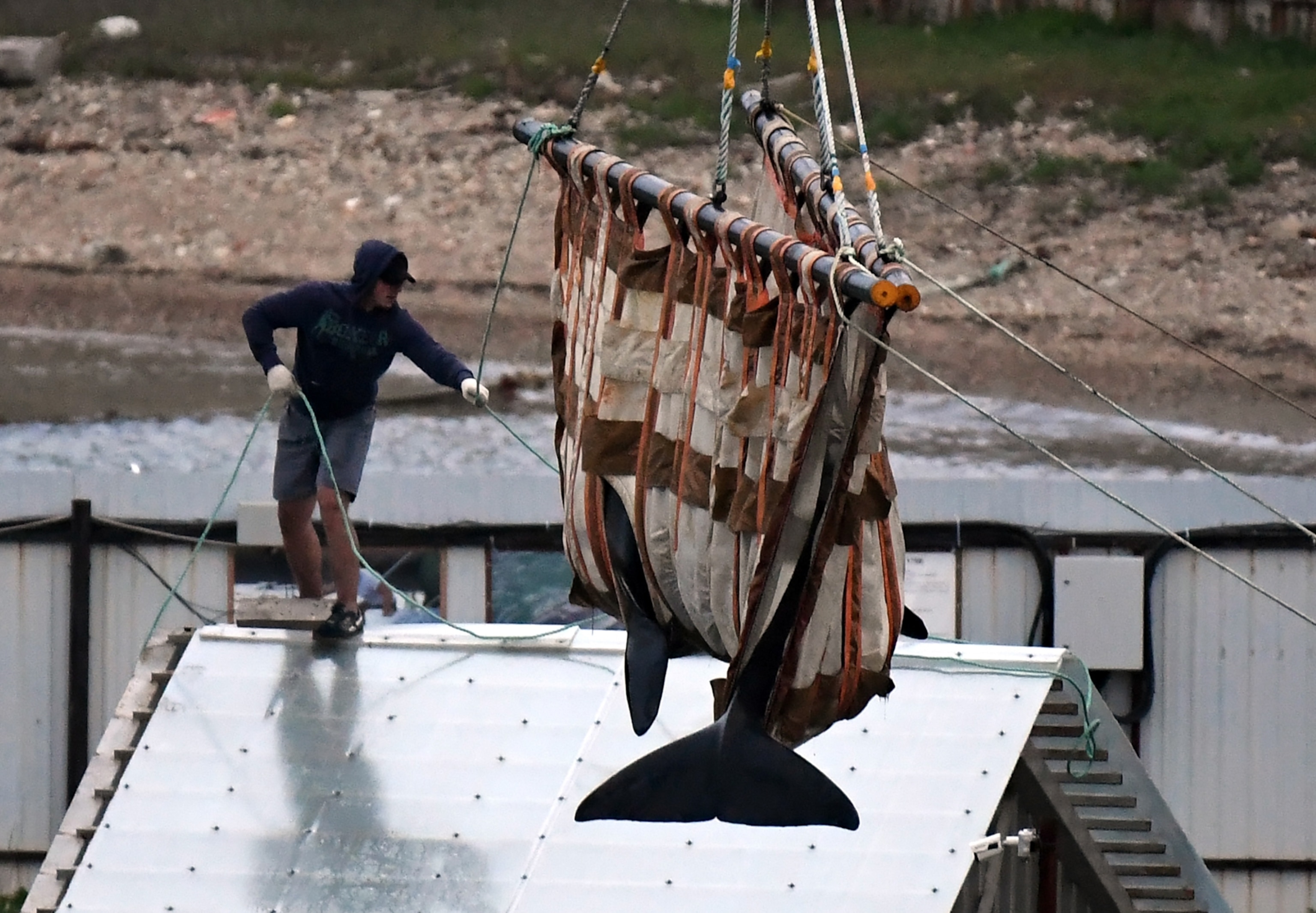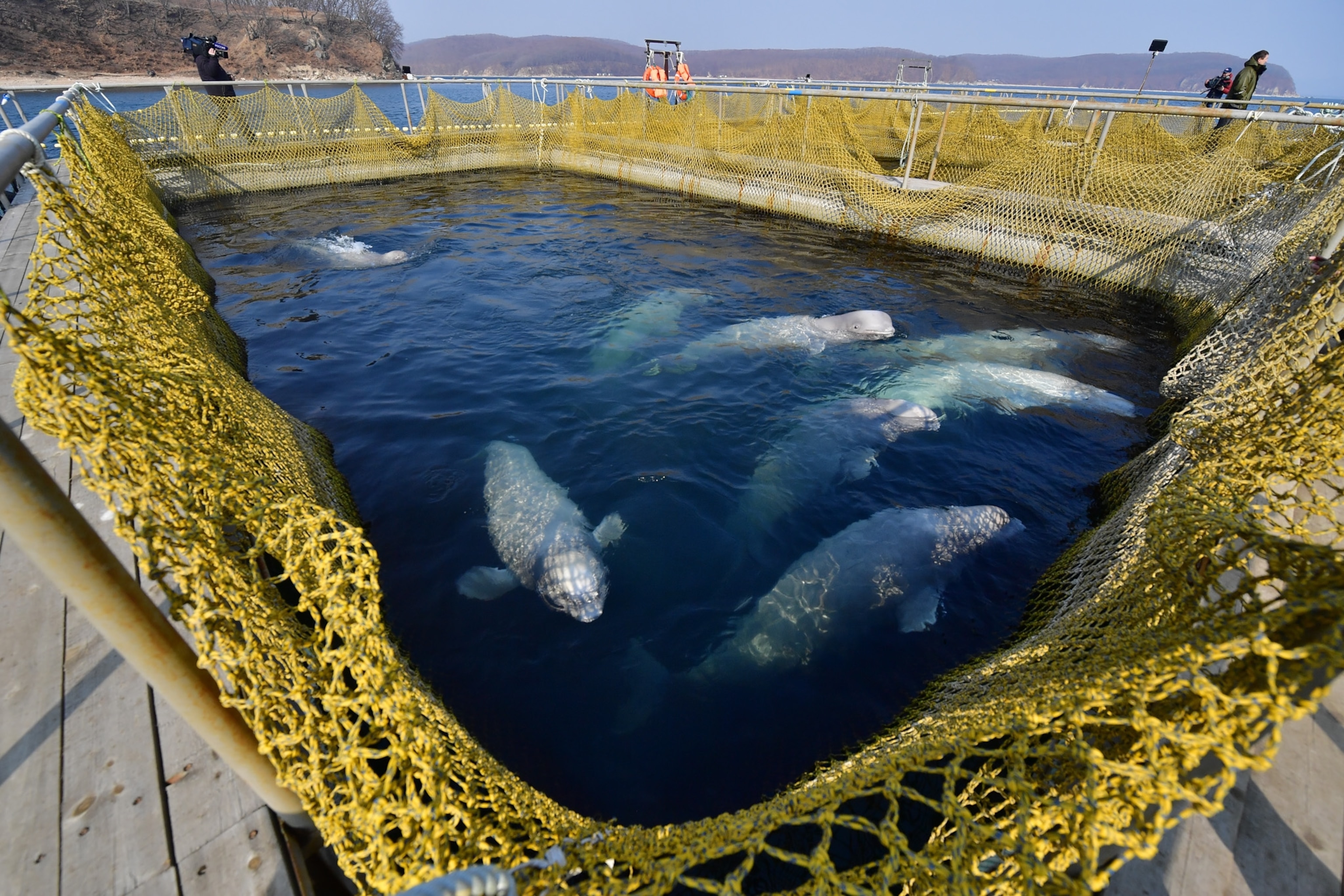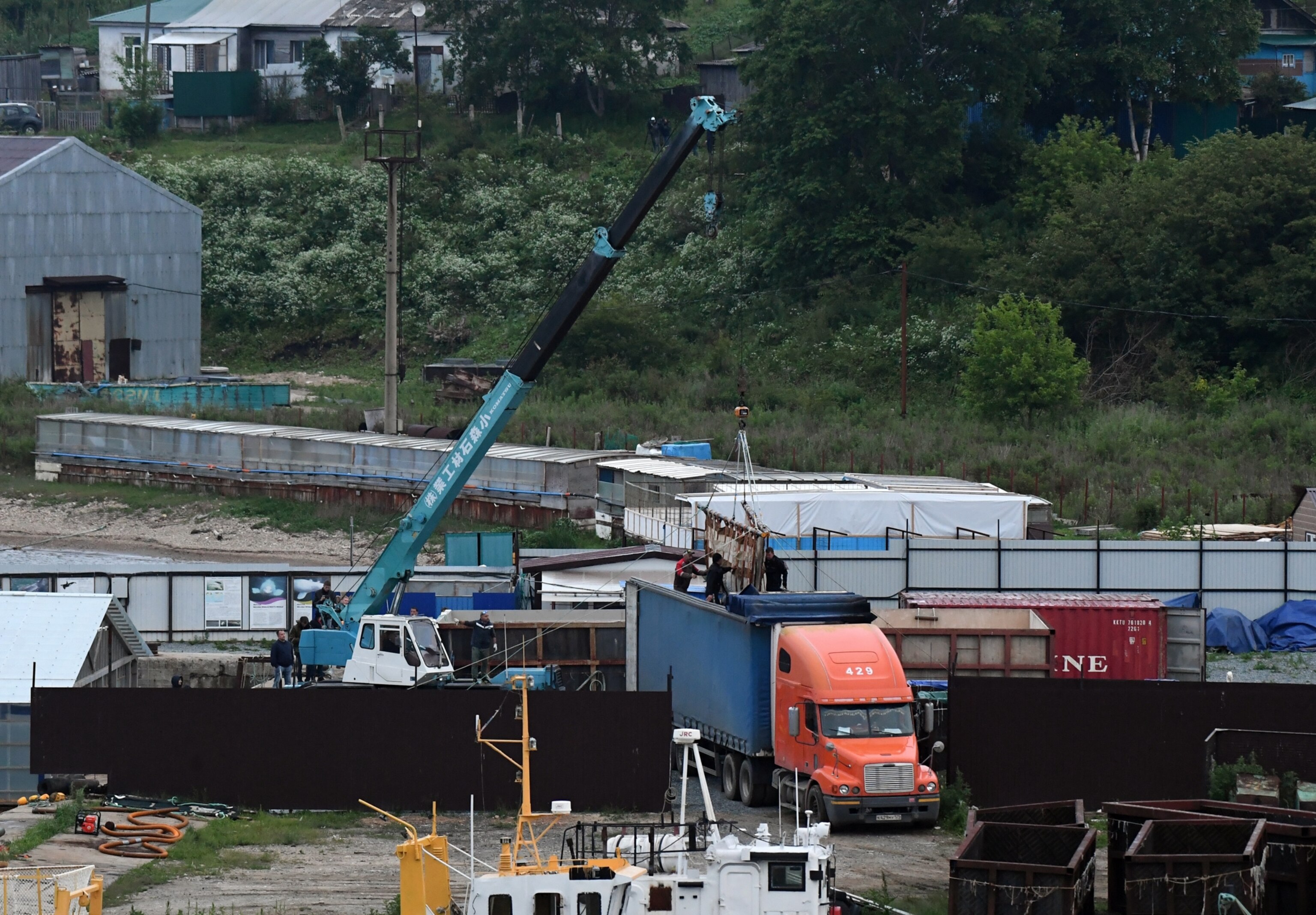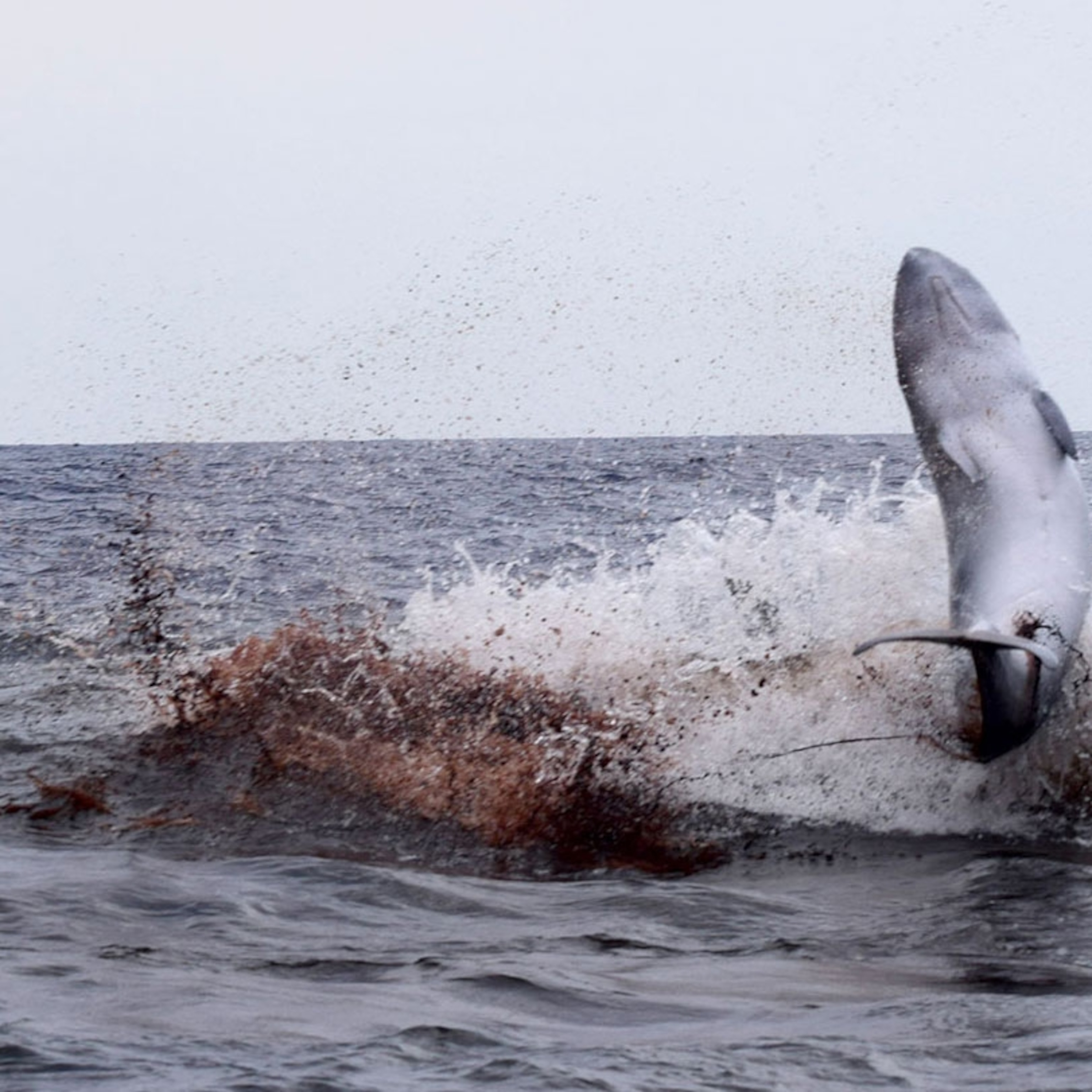
Release of whales from notorious Russia ‘whale jail’ complete
After nearly five months, authorities have completed the release of all 97 orcas and beluga whales.
In what have since been declared illegal captures, four Russian companies that supply marine mammals to aquariums caught almost 100 beluga whales and orcas over the course of several months in the summer of 2018. The animals have been in holding pens in Srednyaya Bay, in Russia’s far east, ever since.
("Shamu" Kills Trainer--Killer Whale's Act Not Normal)
Today, the Russian government began the process of returning them to the wild, announced Deputy Prime Minister Alexey Gordeyev during President Vladamir Putin's annual televised public call-in program.

Authorities from VNIRO, the Russian Institute of Fisheries and Oceanography, have begun moving the first eight animals. Six belugas and two orcas were lifted in slings by cranes and prepared for transport. They’re to be released in the Sea of Okhotsk, roughly 1,100 miles away, where they were originally captured. The journey, by truck and by boat, will likely take about five days, according to Charles Vinick, executive director of the U.S.-based Whale Sanctuary Project. He has been in contact with Vyacheslav Bizikov, the deputy director of VNIRO, who is overseeing the transport and release.
Gordeyev said it will take four months to move all the animals and that the cetaceans will be released in small groups, according to a Reuters report on his remarks. According to a VNIRO statement translated by The New York Times, the cetacean transport will be monitored by 70 specialists, including veterinarians and scientists. Each whale will be accompanied during transport by two people and will be equipped with a GPS tracker before release.
“We have taken the only sensible decision at the recommendation of scientists to rebase the animals to their natural habitat where they were caught, to their familiar environment,” Gordeyev said.
The orcas and belugas attracted international attention in late 2018 and early 2019 when a drone captured aerial video footage of the facility, which showed 98 orcas and belugas crowded in small sea pens. The footage led the media to label the facility a “whale jail.” The situation sparked outrage worldwide, both over the capture itself and the the cetaceans’ treatment
At the time, three of the four companies maintained that the animals were captured legally, and the fourth did not respond to requests for comment. None has made any public statements since the release process began.
Transport begins
Putin personally monitored the start of the transport operation via live feed, reports EastRussia, an English-language Russian news outlet. The Russian president commented on the release, according to a BBC translation of the Russian televised program. "The killer whales alone—as far as I know—are worth around $100 million," Putin said. "When it's big money, problems are always hard to solve. Thank God things have started moving."
Western aquariums are scaling back on keeping cetaceans in captivity (Canada last week banned the practice altogether). But in China, dolphinariums with wild-caught animals are a booming business: There are now 78 marine mammal parks and 26 more under construction.
Vinick says transport back to the waters around Sakhalin Island in the Sea of Okhotsk “is the right decision.” In April, he was invited by Russian authorities, along with Jean-Michel Cousteau, founder of the California-based nonprofit Ocean Futures Society, to assess the whales’ condition and draft a rehabilitation plan. After their visit, they published a joint report stating that most of the animals had skin lesions, which could indicate health issues, and that they would require further health assessments. But they noted that all appeared to be well fed and had undergone minimal training. The report concluded that all 97 could be rehabilitated and released.
Vinick says the team recommended more significant rehabilitation prior to transport and release, to ensure that the animals were in good health. “While every detail is not perfect,” he says, “we have been told that they are trying to follow as many of the recommendations [that] our international team provided as they can.”
“Monumental” change to come?
Deputy Prime Minister Gordeyev also said Russia will clamp down on the capture of cetaceans and that the government will change the law that currently allows the capture of cetaceans for “educational and cultural purposes,” a loophole that fisheries in Russia have long used to legally capture belugas and orcas for use in aquariums in Russia and abroad, notably in China, as documented in National Geographic’s June feature on captive wildlife tourism. Export of orcas for commercial purposes was made illegal in 2018.

If those changes are indeed enacted, which would require amending federal law, cetaceans could only be legally caught for scientific purposes. It would mean the end of Russia’s commercial cetacean trade, which would be a “monumental” development, says Vinick. “It changes everything about the capture of these animals for public display. That would be leadership by the Russian government for the world to see.”
On May 31, the South-Sakhalin City Court, which has jurisdiction over the area where the cetaceans were captured, declared illegal all catch quotas that the Federal Fisheries Agency issued for belugas and orcas in 2018. In other words, the four firms’ argument that they had caught the animals with government permission was retroactively nullified. As a result, two of the four Russian firms have been fined. On June 7, White Whale LLC was fined $435,000. On June 14, Oceanarium DV was fined $870,000, reports the Moscow Times. The cases against the other two firms, Afalina LLC and Sochi Dolphinarium LLC, are still in progress, the paper reports.
Pens icing over
During their months in captivity, the animals appeared to be suffering, Dmitry Lisitsyn told National Geographic in February. Lisitsyn heads Sakhalin Environment Watch, an NGO based on Sakhalin Island, near where the cetaceans were originally captured, that has been monitoring the situation since last summer.
In November 2018, after the drone footage went public, regional authorities opened an investigation into the alleged illegal capture of the marine mammals. While the investigation was pending, the animals remained in the holding pens. As temperatures dropped during the winter, ice formed over the surface of the pens, alarming cetacean experts in Russia and abroad.

In late February, one of the orcas, Kirill, who had been ill for some time, went missing. Facility owners filed a police report saying he likely escaped. Environmentalists with the Free Russian Whales coalition, who are familiar with the facility, said that escape was highly unlikely. He has not been found.
What’s next
Details are scant on whether the cetaceans will have any period of adjustment once they arrive at the release point, says Vinick. “Our recommendation was that they have some period of time to get acclimated to the area. There are risks involved in any kind of release.”
VNIRO did not immediately respond to requests for comment or further details.
“We could all be second-guessing every part of this, and many people will, and they should,” says Vinick. “But at the same time, we have to be grateful that this is moving in this direction.”








